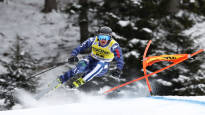Alpine skiers from Finland have reached the top of the world in slalom and giant slalom. In speed sports, i.e. downhill and super giant slalom, i.e. super-G, a rare touch with the top of the world came at the World Championships in Schladming 2013, when Andreas Romar was fifth in the downhill and fourth in the combined super alpine. Since the Finnish national team did not have its own training group for speed sports, Romar, who has now retired, trained in the speed groups of the German and Swedish national teams.
Now, in a similar situation, promising results have been achieved in speed sports last season Elian Lehto23. Rovaniemläinen is already training for the second season with the world’s leading alpine skiing country, Switzerland.
In this training season, about 30 days of camp are behind us in Switzerland, where Lehto lives near Davos. During the competition season, Lehto and his coach Eero Blomqvist is integrated with the Swiss national team, from which all services including ski maintenance are obtained.
Mainly, Lehto trains with pacers who have progressed immediately below the world elite, but also with top men, such as a superstar by Marco Odermatti, by Niels Hintermann, Beat Feuzin or by Stefan Rogantini in a group.
– Odermatt is a relaxed and nice guy and a great measuring stick for what you have to do to get to the top, Lehto tells Urheilu.
Money talks
But in order for a place like this to open up to a foreign accountant at all, something big has to happen on the economic front. CEO of Ski Sport Finland, the alpine skiing association Janne Leskinen understand what kind of investment it is. He himself advanced as a super-G skier to the 1996 World Championship quadruple and trained a lot with the USA national team.
– If all the expenses – athlete, coach, equipment, living in Switzerland and so on – are taken into account, then I believe it will be between 150,000 and 200,000 euros per season. It really sounds like a lot, but it would also be very expensive to start building a speed sport resource for the needs of one athlete within the Finnish national team. Probably more expensive, Leskinen says.
Both Lehto and coach Blomqvist are in the Swiss national team at so-called shopping places, part of which is paid by Ski Sport Finland and part by the athlete’s own sponsors.
– The funding for playing sports is pretty much all right, but I still need to find partners so that I can finance my own living in Switzerland and collect my pension as well, says Lehto, who is pursuing his dreams without a personal manager.
His own father and godfather put together his financial package.
– Switzerland sells such a place and charges a certain table price for it. When other athlete and coach costs are added to that, such as travel, we are already around 100,000 euros at that point, says Leskinen.
Extra pressure
Lehto is not the only foreign calculator in cuckoo clock country. The camps and the team also include accountants from the traditionally tiny neighboring country, the Principality of Liechtenstein.
– After all, the sums are significant and I understand if someone doesn’t know how to put them into perspective at all. Even when I was 16 years old, I wouldn’t even have been able to figure out what kind of sum 200,000 euros is.
Lehto admits that sometimes in the past he took extra pressure from operating in an exceptionally expensive project, from which a hard profit would also have to be extracted.
– I have grown out of such thinking. I know that I appreciate the people who have helped and financed me the best in the way that I put everything I can find into it every day. I don’t want to get caught cheating.
In the Finnish A national team, Lehto would pay a deductible of about 20,000 euros for the season; of course he doesn’t have to pay for that now. Also in Switzerland, deductibles are collected in the alpine national team, but in a very different way than in Finland. Every skier gets to get a sponsor for the most coveted advertising spot, i.e. his helmet. From this amount, each pays a 15–20 percent share to the Ski Association.
Two contracts
Sports expert Kalle Palander knows the tricks of the trade:
– Two contracts are typically made in Switzerland for that helmet contract. The association’s share is billed from the basic advertising contract. Then another contract is made, which agrees what the alpine skier gets from the company for other jobs, such as fair days, company visits and the like. It can be clearly more expensive paper.
Palander considers Lehto’s heavy financial investment reasonable. The Finn finished 7th in the downhill of the Junior World Championships in Norway 2020. Last season, he was twice in the top 30 in the speed events in both the World Championships and the World Cup.
– A really potential guy whose moves attracted a lot of international attention last season. This is a handout from Switzerland. It doesn’t need Elia Lehto for anything. But I know the coaching culture of the country so much that if Lehto puts locals in the pot during training, the outcry will be loud. You can’t lose to a Finn, Palander laughs.
